Thanks, that’s a great idea! Exactly the kind of fresh angle I’ve been hoping for.
It’ll take some core-loop changes, but it could fit beautifully with the upcoming procedural elements. I’ll definitely be trying it out soon.
🕹️ https://mobilelast.itch.io/hanaa
Hanaa is an experimental yet accessible turn-based local-multiplayer racing game where players compete by carefully aiming and launching their cars. It’s designed for quick, chaotic fun; perfect for friendly couch competition.
Version 0.9.0 is out now! This update adds an in-game video tutorial, improved driver visuals, several quality-of-life enhancements, and more refinements across the board.
Highlights:
A free Windows demo is available. Give it a try and let me know what you think! Your feedback really helps shape the game.
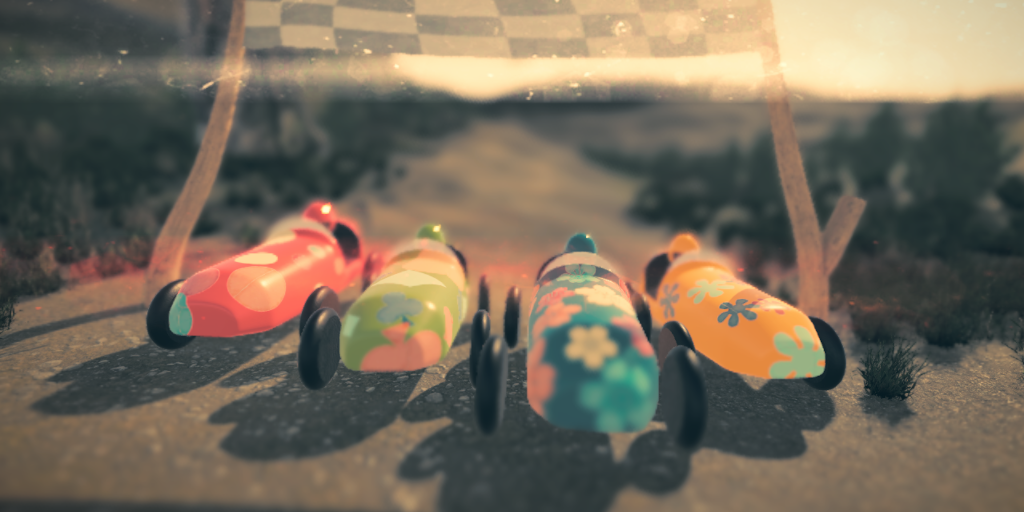
A very funny, compact game! It leans into what it does well, and it doesn’t feel like anything essential is missing.
At first, I suspected that the low resolution might make distances, physics, and collisions hard to read, but the minimalist style actually works well. The hoop vibration, sound effects, and other feedback are spot-on, transitions are quick, and everything feels fluid, making it easy to adjust the following throw.
Not having any HUD indicators actually makes throwing feel like a real thing. And as I suck at this game as much as I do in the real basketball, I guess there must be some realism involved.
I tested the browser version with relatively good hardware, so obviously no performance issues.
🕹️ https://mobilelast.itch.io/hanaa
Hanaa is a casual, experimental party game that blends minigolf mechanics with toy car racing. Aim your shot, give your car a push, try to stay on the track, and reach the finish line before your friends do! Perfect for game nights, families, or laid-back local multiplayer sessions.
Version 0.5.0 brings a wave of visual improvements and common bug fixes to smooth out the ride.
Highlights:
🎮 Try the free Windows demo and let us know what you think—all feedback is welcome. Thanks for playing!
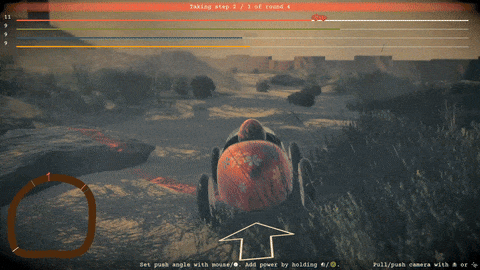
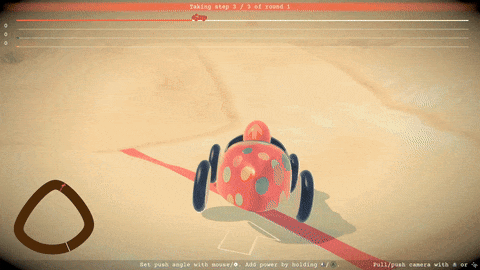
We tested the game remotely using Parsec, and a couple of new suggestions came up:
While playing via Parsec, we encountered noticeable client-side FPS stuttering when running the game in full screen. We didn’t have time to investigate further, but switching to windowed mode resolved the issue completely. This could be related to Parsec, vsync, or other configuration specifics rather than the game itself, though it's worth noting that we haven't run into similar issues with other games.
As expected, playing in multiplayer was even more fun, and we’ll definitely return to the game again in the future.
Coincidentally, I had just cycled through real-life Pirkkala before installing this. Luckily, the traffic there isn’t nearly as rough as in the game. So far, I’ve only tested it solo, but since this definitely seems more fun with a friend, I’ll return once I find one.
The rhythm is excellent, with no downtime between races or after failures. As a result, even though the game can be frustrating (as these kinds of games should be), it kept me hooked until I finally managed to beat the computer opponent for the first time. (That said, perhaps starting with a slightly easier AI would help new players ease in.)
I performed better using the first-person view. In third-person, the limited forward visibility often caused me to steer off the track. There’s a risk that the game may turn more into a memorization challenge rather than a reactive one. My notoriously poor reflexes would certainly appreciate some advance warnings like traffic signs or indicators showing the direction of upcoming turns.
The addition of windowed mode was great. I played the Windows standalone version on a fairly large display, and the huge pixels can be quite straining when sitting close. This game definitely feels more comfortable on a smaller screen.
I also noticed that gamepad controls aren’t mentioned anywhere, though they were intuitive enough to figure out.
All in all, it’s an instantly recognizable game with a fun premise and a solid implementation. Who wouldn't enjoy a huge-pixel drunk-driving simulation with a police car; even the run-over victims seem happy. I’m looking forward to seeing where this goes next.
https://mobilelast.itch.io/hanaa
Hanaa is a laid-back, local multiplayer racing experiment where you aim, push, and hope for the best. With its casual, turn-based gameplay, it’s perfect for more or less friendly competition and quick bursts of fun.
Version 0.3.0 brings lots of gameplay improvements, tweaks, and fixes — plus a brand-new, easy track designed for fast and accessible games.
Download the free Windows demo and give it a spin! As always, your feedback is incredibly valuable and appreciated.
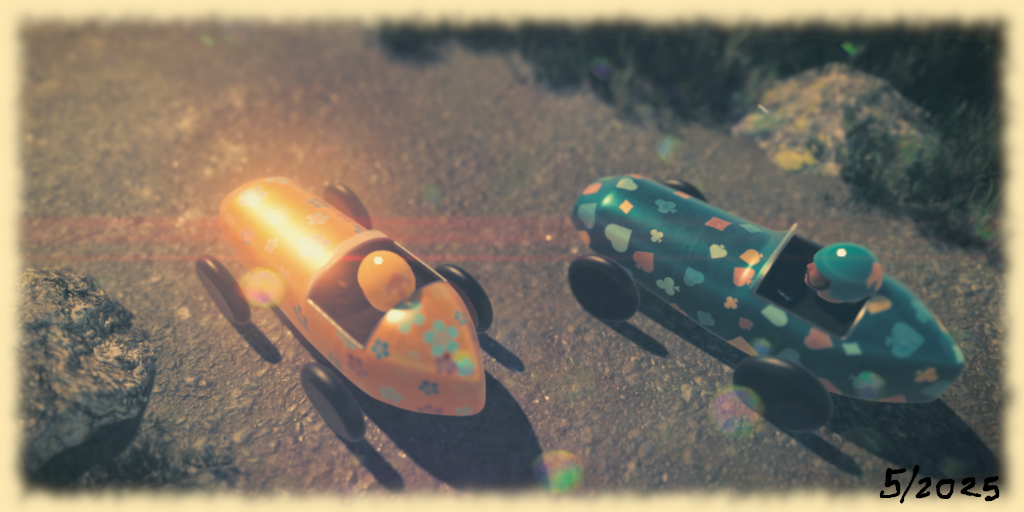
I remember enjoying the 2D version a long time ago — guess I’ll have to revisit that too. It may have helped, since the mechanics here were easy to pick up after just a bit of experimenting. No explanation needed, which is always a plus.
Some observations:
All in all, the third dimension is definitely a beast, but you’re already doing a good job taming it. I hope you continue working with this. The training ground has some nice level design, and being allowed to resume where you fell off made it enjoyable. It avoided that overly punishing feel games like Chained Together tend to go for. I kind of hope you don’t go that route — but then again, a lot of people love that kind of pain, so maybe I’m not the best person to ask.
I’ve always had trouble telling left from right, so this game was pure torture for me. The concept is great, and thankfully it’s just as funny as it is frustrating, so I never felt discouraged.
A few thoughts:
This is absolutely worth expanding. Dynamic obstacles like pedestrians would be a hilarious touch. And a multiplayer mode where one player gives instructions while the other drives.
Thank you for the throughout feedback! And not nitpicky at all, I found them extremely helpful. Many of the issues were risen by others and me already. And writing answers actually brought me some new ideas too, which delayed the answer a little.
Music was nice but at times very repetitive
I agree. The idea is to create distinct audio background for each track, eventually in a procedural way. But it's still very much a work in progress.
Staying on the road was hard as it's not super clear where you can land and if you can take any shortcuts
Combining sandbox aesthetics with clear visualization definitely has its challenges. Unity's terrain tools aren’t ideal, so I’ll likely need to write a custom utility to paint the terrain so it aligns precisely with the track. Adding flashing indicators for track limits and other players' positions at the start of each step could also be helpful.
The game feels slow, the first lap took forever
I was also surprised by how long the races can take, especially with four players. A quick, straight starter track could be a solution. Right now, the engine only supports looping tracks, but that should be easy enough to change.
Maybe there could be some minigolf-like shortcuts that you could miraculously take
At the moment, the track is made from a single spline, so branching isn’t possible, and it will take some time to fox that. However, features like teleporters, no-stop zones, and other elements for shortcuts and penalties are already planned and definitely doable. I also need to make the physics more predictable so players can intentionally aim for those areas.
The ghost cars of other players are shown where the end up, even if they've ended up off-road, almost felt like bug
Yeah, I wasn’t quite sure what to do with inactive cars, so for now I just left them where they are. The ghost car material doesn’t look great anyway, so I’ll probably replace it with a fancier disappearance effect.
Perhaps the power meter could yoyo between zero and max power instead of just going full force if kept pressed for too long
Good idea. It’ll require a few adjustments to the timeout and incoming tiebreaker rules, but it shouldn’t be too difficult. That said, there’s always the risk it could slow down the pace even more.
Maybe a casual setting could be nice, that would automatically adjust the settings to the most beginner friendly options
There aren’t many settings that directly affect difficulty at the moment, but a shorter and easier default track would probably make the game more approachable.
The game looks nice, the pine cones especially were a nice touch
The cones were actually the musician’s idea. More procedural and moving obstacles are on the way — one I’m especially excited about is insects walking around the tracks. Dynamic elements caused a bunch of special cases that weren’t handled well in version 0.1.0, but those should be fixed now.
Thanks again for the feedback — feel free to send more my way anytime! Meanwhile, I’ll add these to my TODO lists for future versions.
I didn't have anyone to play with this morning, so my observations may be a bit surface-level (though I have to say, controlling two ships at once was surprisingly addictive).
Even with just a little experimentation, the game already feels well thought out. I liked the small details like the simulated environment, acid, and the way mechanics are conveyed through observation rather than explanations. That said, I sometimes found it difficult to determine the ship's forward direction, which made flying feel a bit too hazardous.
One issue I ran into: my Xbox controller didn’t work in the main menu, and in-game, it only allowed me to steer using the D-pad. Interestingly, my Logitech controller didn’t have these problems. EDIT: This was a browser-related issue. The standalone version works fine. Well, except that it crashes when quitting.
I’ll be back with more refined thoughts once I find friends.
https://mobilelast.itch.io/hanaa
Hello, mini-golfers of the racing world. This one's for you!
Hanaa is a turn-based multiplayer racing game with a moody ’70s vibe — laid-back and casual. Just aim, push, and hope for the best.
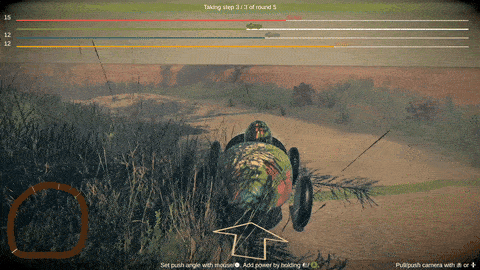
Bug reports and general feedback are highly appreciated. Thanks in advance!
If old thruster flames bore a resemblance to clouds, the old meteors could pass for meatballs. They were crafted hastily several years ago to replace the placeholder spheres. Models themselves are OK, but enhancing their texturing has lingered on my to-do list since then.
Substance (at least the 2021 version) lacks built-in rock/stone material, but I found concrete to be a solid foundation to build on. I incorporated robust bump mapping to lend it a rougher texture, adjusted its hue to a bright white, and fine-tuned the diffuse multiplier in Unity to achieve the desired brightness.
ATP employs a top-down perspective, and owing to its 2D physics, meteors are restricted to rotating around the top-down axis to maintain proper collider alignment. I leveraged this limitation to my advantage, and optimized the texturing by giving most of the UV-space to faces oriented towards the camera.
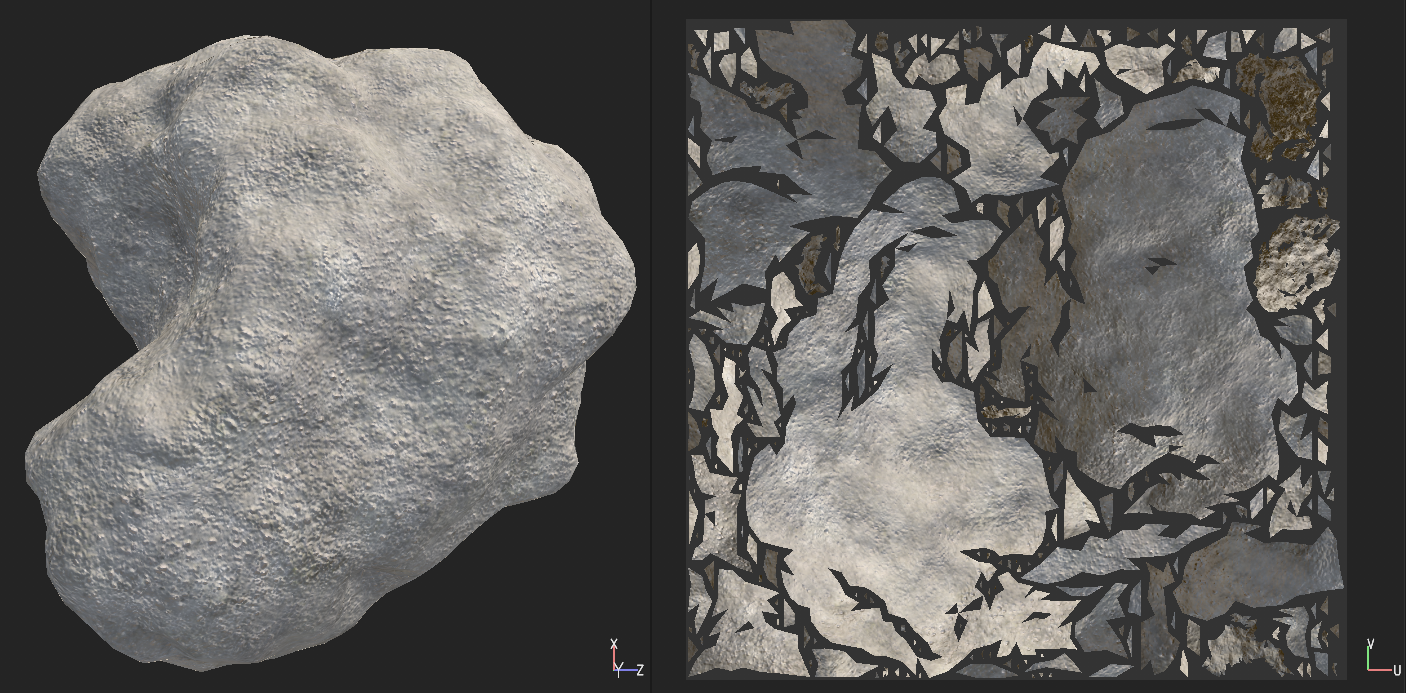
With a little imagination, they now bear a distant resemblance to meteors. And with the same effort, I added a few new meteor models to add variance.

It appears that Unity's collision model may have undergone some changes, as I encountered inaccuracies that went unnoticed previously. Using the continuous collision model resolved these issues, and given the absence of performance degradation, it will now be set as the default option.
As mentioned earlier, expect numerous visual enhancements now that all graphical tools are running smoothly. Let's begin with one aspect that has particularly bothered me: the puffy clouds that were supposed to be thruster flames.
I created a basic half-sphere to serve as the model for the flame, allowing thrust power to be indicated simply by scaling it. The flame's appearance is achieved through a shader. Initially uncertain of the desired outcome, I experimented with smooth noises, Fresnel nodes, and other elements until I achieved a satisfactory result, especially when viewed from a distance.

And there you have it. While it may not be a contender for any beauty contests, at least the thrust direction is now clearer.
A closeup:
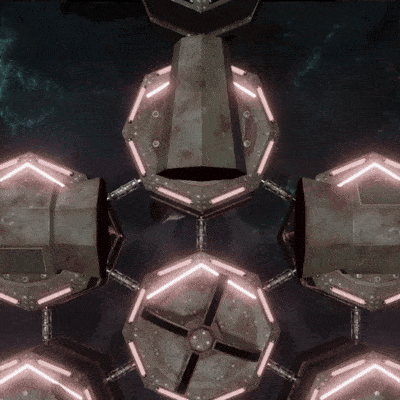
From a distance:
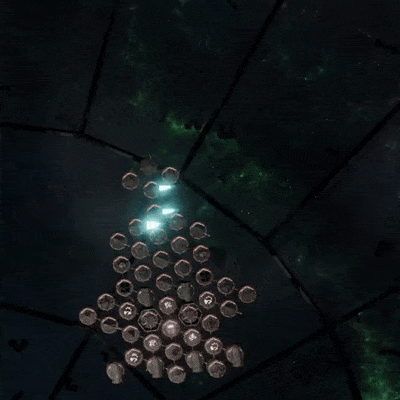
I’ve dreaded the transition of the project to a new device, fearing it would be a frustrating ordeal since I don’t store binaries to a version control. However, my computer's incessant noise finally spurred me to upgrade it. Much to my surprise, the process was completed in a mere 15 minutes or so.
The Unity upgrade from 2022.3.2f1 to 2022.3.21f1, on the other hand, didn’t go as smoothly. VFX graph effects exhibited numerous glitches, accompanied by "empty subgraph block" and "empty subgraph operator" errors, likely stemming from serialization issues. Fortunately I’m not that much into fancy effects, since I had to fix all of them manually. Despite this hiccup, overall functionality remained relatively smooth, although there may still be lingering undetected issues.
Now that I can effortlessly run Unity, Visual Studio, Blender, Substance Painter, and manage dozens of browser tabs simultaneously, expect some visual changes that I'll detail in upcoming posts.
How time flies...
As you might guess, I have distanced myself a little from ATP recently and delved into various other interests. These include all kinds of procedural stuff, water effects, volumetric lights and terrains, JPS-pathfinding, inverse kinematics, genetic algorithms, and more. I've also initiated a couple of new projects that I look forward to sharing more details about in the near future.
I'm finding myself a bit short on fresh ideas for ATP as well. My primary objective for this year is to polish the game as ready as it can be; while I'm open to any suggestions during this phase, my focus will predominantly be on refining existing elements. So I’m not quite done yet, but my posts will probably be more sporadic in the future.
But most importantly, I added a shockwave effect to enhance the ship's destruction:

During the last, unfortunately busy weeks, I’ve been continuing where I last left: improving the trigonometry behind the behavior and refactoring the logic. In the process, I also thoroughly tested almost all AI behaviors. A tedious job, but a boring person that I am, I found it rather interesting.
Here’s a little summary:
Only the two most difficult things are still to be done: movement and plasma orb handling. More about those later.
And in order to avoid another tell-don’t-show -post, here’s an image that introduces the new tractor and pressor beams. Direction of the beam should now be clearly visible.
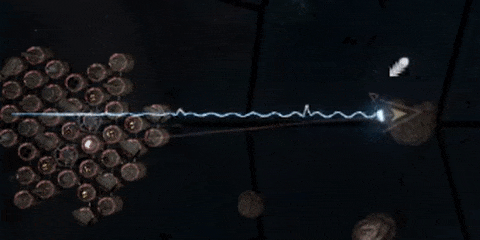
Programming NPC AI is rewarding once you get into it; you never get tired of losing your own creation. On the downside, developing and testing requires lots of hard debugging as well as complicated play/cheat modes that take time to set up. Therefore I usually concentrate on AI for longer periods at once. Such as the last two weeks.
In addition to countless tweaks and fixes, there are several new features and improvements. AI players...
All AI skills and characteristics are configurable. According to my plans, the next version introduces nine opponents in three different tiers, each having their own personal fighting style. I still need a set of portraits, new player selection GUI and all kinds of visual things that are not my strength. Slowly but steadily...
What an interesting Unity-week... Certainly not the first controversial decision they make, but since it doesn't directly affect ATP, I'll see how things progress and perhaps return to the subject later.
Meanwhile, it’s time to once again introduce something completely meaningless with absolutely no effect on the gameplay: Mauno, the flying mediacube, who so far has entertained the audience with error screens and static, is now capable of showing videos. Its favorite subject are clips about the old ATP versions.
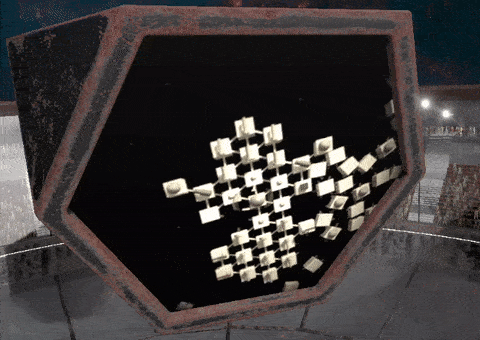
I haven’t figured out what Mauno’s displays are supposed to be. They’re really neither film projectors or TV screens; perhaps some kind of weird film-TV screens or something. But it doesn’t matter: as I’m after the early 1900’s style, I added a vignette film grain to the videos by loosely following the ideas presented in this great article.
Videos are rendered to texture by using Unity’s VideoPlayer-component, which is surprisingly straightforward to use. There are some potential compatibility issues with certain platforms. Importing video clips by using VD8 encoding should maximize compatibility, but I have to do some testing on this, especially on Linux.
Beside numerous bugs, Avaruustaistelupeli is filled with weird game-overs that are logical under the hood, but the logic is hard to figure out. Lots of them can only be detected by carefully watching videos of the battles. I have already added some statistics to clarify things, but obviously it is not enough.
A very common mishap happens when players launch projectiles at high rate. Projectiles often collide and explode upon the ship that launched them, which causes heavy collateral damage to modules in their vicinity. Explosions near the cockpit may end the battle abruptly.
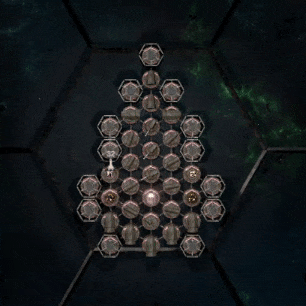
Players are now given an opportunity to make projectiles trigger only when they leave the ship’s bounding area. Untriggered ones won’t explode on collisions, only disappear. A dust cloud with a loud clang indicates the collision and lessens confusion on vanishing projectiles. The new mode should make the fighting more careless. As AI pilots are already rather careful with projectiles, this doesn’t affect their behavior.
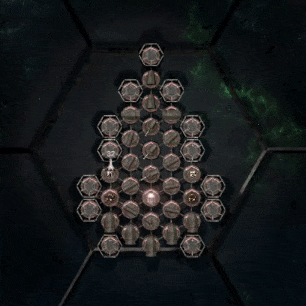
Another similar case are mishaps with energy overflow, but I’m pretty clueless what to do with them. Experimenting with the subject has already taken too much time, so, in order to keep a steadier posting rate, I will probably do something else first.
As I expected, there has been little time for ATP this summer. Besides the normal boring vacation and day-job things, I took my precious time to prototype a new concept that I will tell more about in the future (once I figure out what I’m actually doing). It has nothing to do with ATP, but lots to do with Unity's SRP-features and other advanced, new, poorly documented stuff.
Although not practicing any serious development, I did try to make the game moodier and more lively, adding funny little details with no gameplay value whatsoever. For instance there are now dozens of 1910's t-model spaceships flying behind menus; spectators have to arrive somehow. As you can see, their ships are much more maneuverable than the ships used in battles. Arena also has lots more parking space than one would believe.
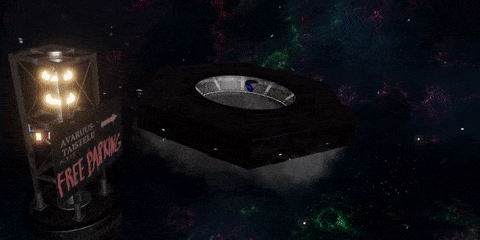
Animations are done by using Unity’s new splines-library. There is one entrance for each side of the arena, totaling six. To save time, I created several alternative splines for one entrance (within SplineContainer-object), and copied the bunch to five others. Ships select their route randomly, and they are animated by evaluating along the selected spline in the code. To introduce more diversity, I incorporated individual variations using Perlin noise and curve tangents.
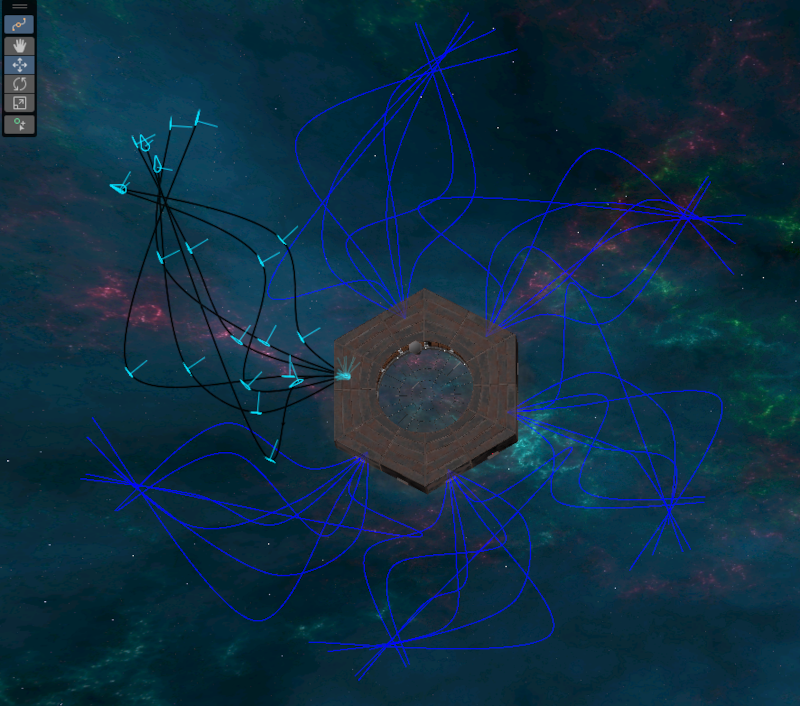
I found the spline editor GUI to be somewhat awkward to use, and (unlike the spline node visualization implies) Unity seems to ignore the spline object’s world transform. As spline containers for each entrance differ by rotation, I had to do the transforming manually in this manner (feel free to comment if I’ve missed something):
var root = objectWhereTheSplineContainerResides.transform; var position = root.TransformPoint(spline.EvaluatePosition(time)); var forward = root.TransformDirection(spline.EvaluateTangent(time));
But that’s enough cosmetics for now; there are some real features I need to implement too. AI is already somewhat able to operate shredders, but it still has plenty of tricks to learn. Some improvements to gameplay mechanics are also on my TODO list. So in the following posts, I’ll be returning to the more meaningful stuff.
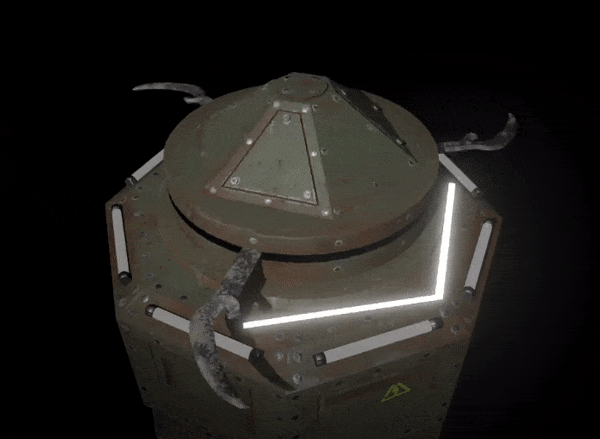
There, I added a brand new module type, the Shredder. It’s the first new module for over a year, so re-learning modeling and texturing process was quite a job. Softwares tends to change drastically in that time, but as my Substance license only covers the 2021 version, I was able to proceed with the old version; I like to consider myself lucky.
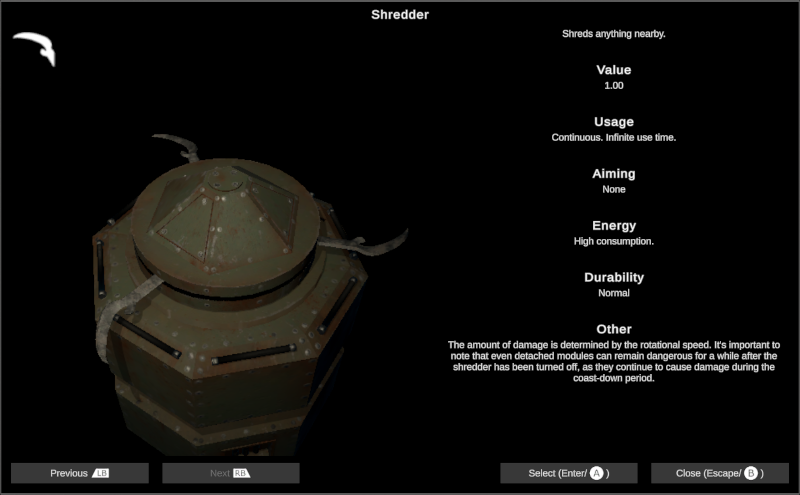
Shredders deal massive damage to all objects within their reach. They are efficient when ramming into enemy ships, and can also clear obstacles from the way. My goal is to make them emphasize movement: the ship's body can now be used as a weapon, and one must also be ready to escape the enemy blades. Other movement-related modifications and additions are also under way. Mines should also be more useful now, as they seem like a feasible way to battle against the shredders. Here’s a clip about shredders in action:
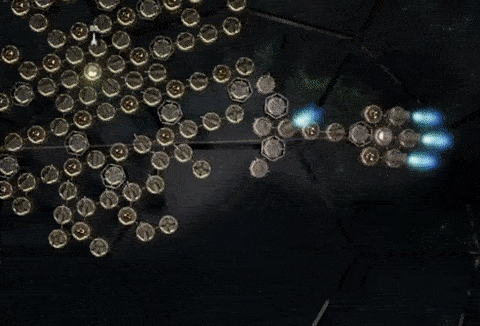
Functionality itself was pretty straightforward to implement, basically an overlap cast and damage to nearest enemy or neutral objects. With a little twist, of course: blades don’t stop immediately, but decelerate over time, which makes them potentially dangerous even when detached.
The only thing left is the hardest part: AI. As shredders require advanced movement handling, I will probably implement that as a part of the larger AI overhaul in the near future.
I updated Unity to the latest LTS version 2022.3, and was pleasantly surprised how few issues there were.

The newest URP should support LOD crossfade, but I ended up having nothing but an error “Instancing: Property 'unity_LODFade' shares the same constant buffer offset with 'unity_RenderingLayer'. Ignoring.” Probably a compilation problem; maybe I should update Visual Studio as well.
My interest in LOD transitions is related to a new module type which I will tell more about in the near future. Time to re-learn Blender after a short break.
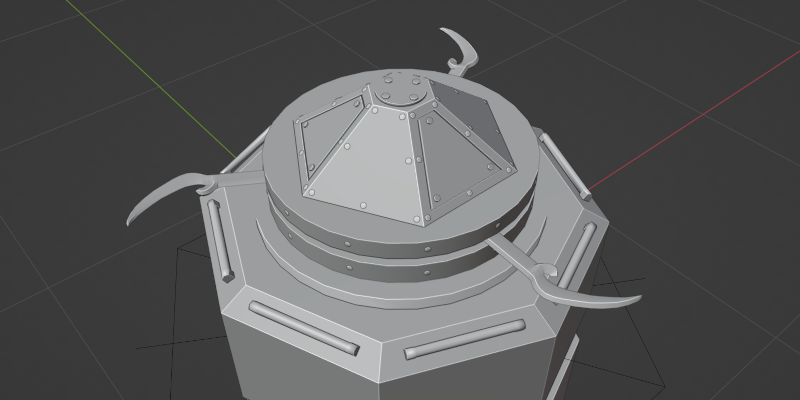
Summer has arrived, and rising temperatures tend to slow down my working rate. The original idea was to write a tutorialish post about shader tricks I’ve been playing with, but writing takes so long, I’ll publish it a little later. Something else instead.
One particular thing has always bugged me during the test sessions: as there can be dozens of ships to choose from, it takes ages to find properly balanced ones for each player. As most ships on my computer are unusable test ships that I use in development, this may not be a problem for others. But still, I decided to take things from this
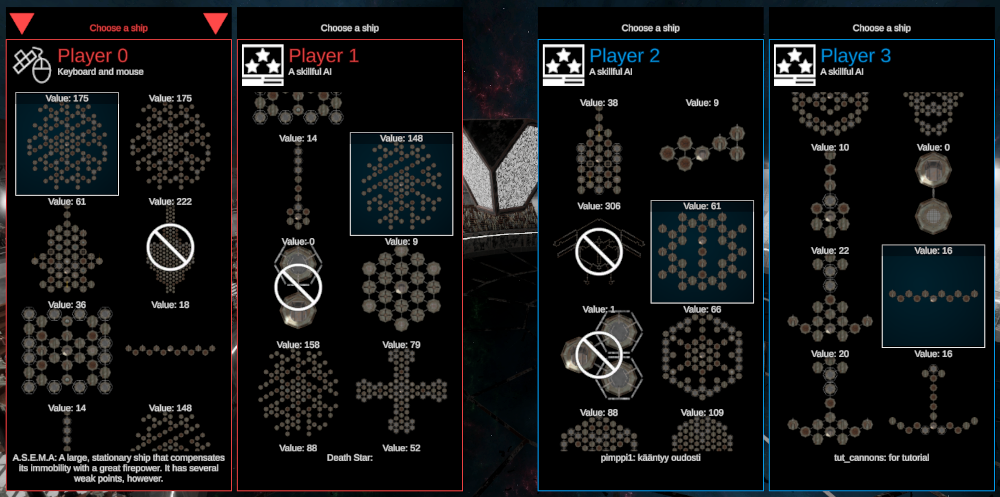
to this
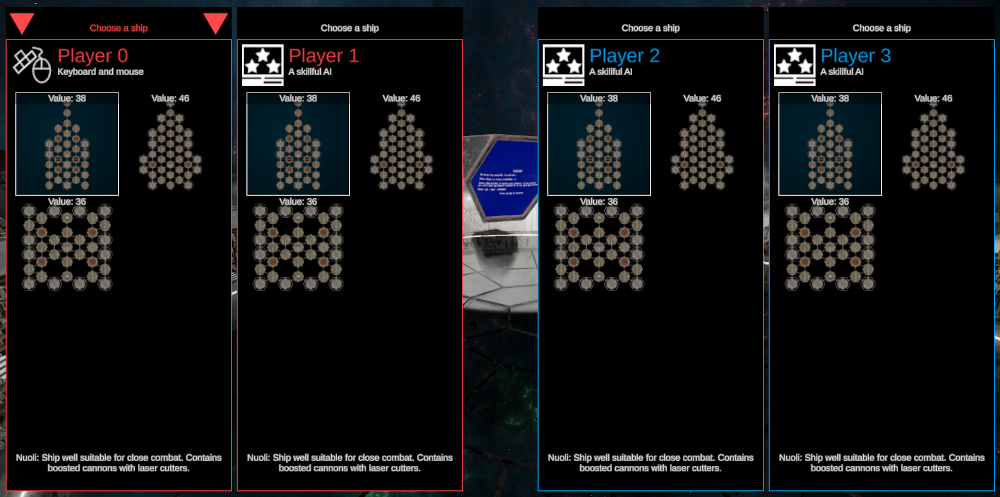
In the next version, fleets can be used in all game modes, not only in tournaments. Fleets will be somewhat similar to folders, and there can be specific fleets for each game mode. This limits the number of available ships, speeding up the selection process. As the fleet-system was hastily done and not very cleverly designed, it took some refactoring to resolve the curious connections between game mode, fleet model, GUI and other places. But other than that, the change wasn’t as big as I feared.
My next short term goal is to update Unity into the latest LTS version (2022.3), and not to break everything in the process.
So far the AI combatants haven’t been capable of collaboration, which is why the cooperative mode is currently artificial and limited: only one AI player against one to three humans. This will change, as 0.5.3 will introduce a fully featured team mode (still limited to four players, though). In the future, human(s) can fight against multiple AI combatants, team up with them, even battle against others with AI wingmen.
As you can imagine, this causes major changes in AI, interface as well as other, yet uncharted places. Firstly, I had to teach the AI not to target or escape its teammates, be careful when they get in the way, not try to shoot through them, and handle their ships as obstacles that should be dodged. Although I would never trust my life with them, the AI pilots already work surprisingly well with those changes. Some sort of tactical awareness must still be added in order to make AI teams battle as a unit. And of course, there has to be lots of issues I haven’t bumped into yet.
Additions to game creation and ship selection screens are needed. Menus will be completely redesigned at some point, but I made a rough implementation that should include all the mandatory functionalities (with lots of unexpected special cases).
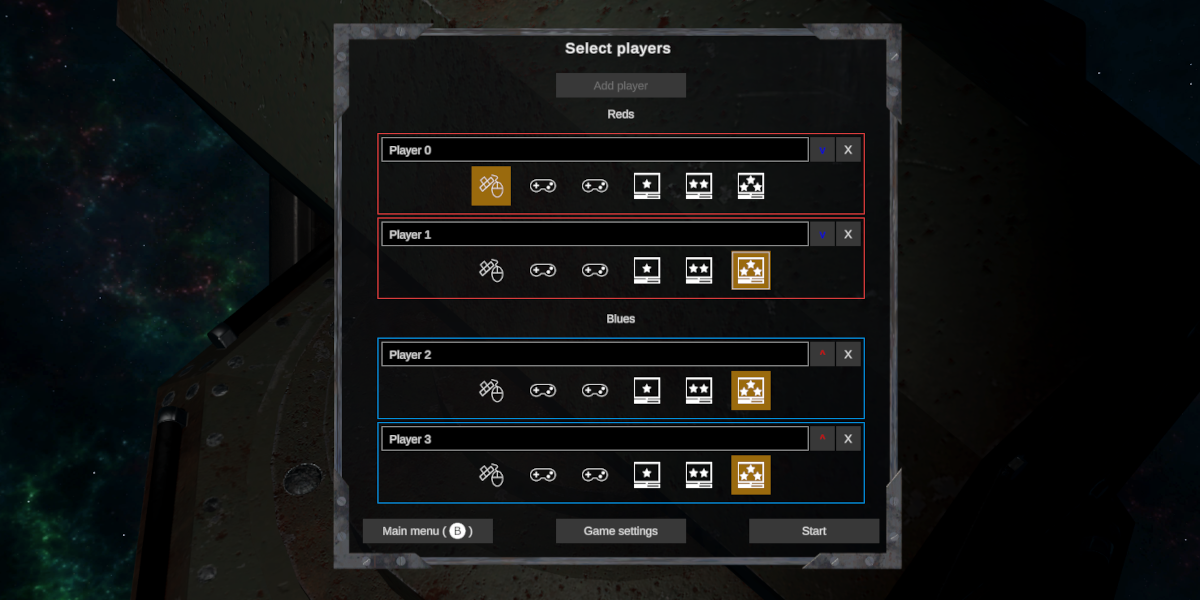
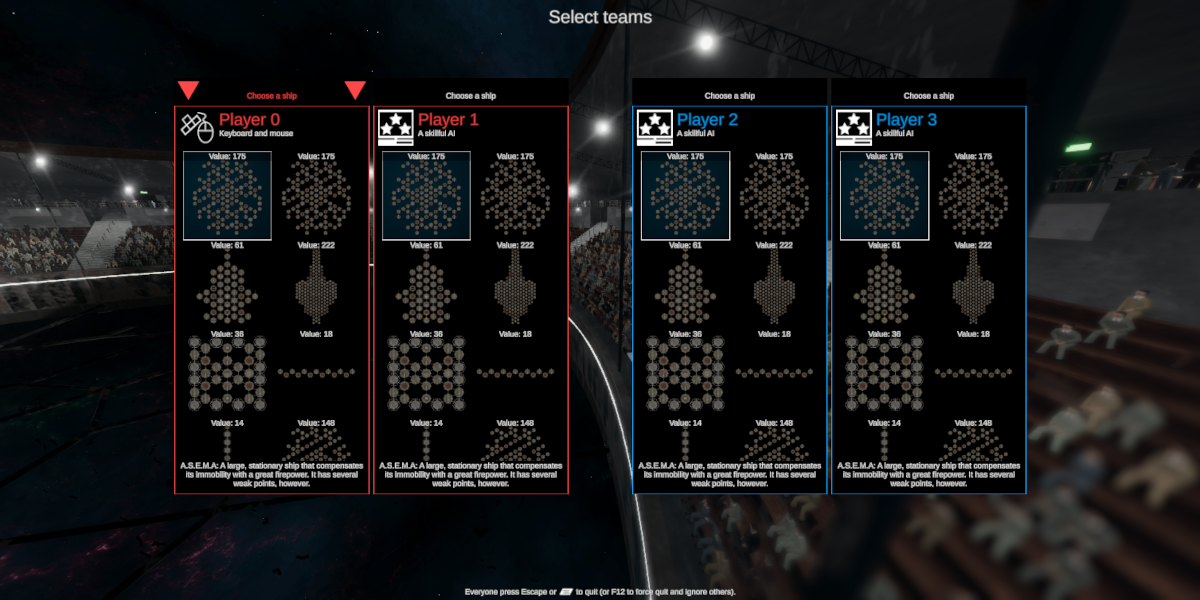
Players must distinguish both their own ship and their teammates, which makes it hard to find good colors. For now, all team members share the team’s color, but I will try different red and blue variations for each individual in the future.
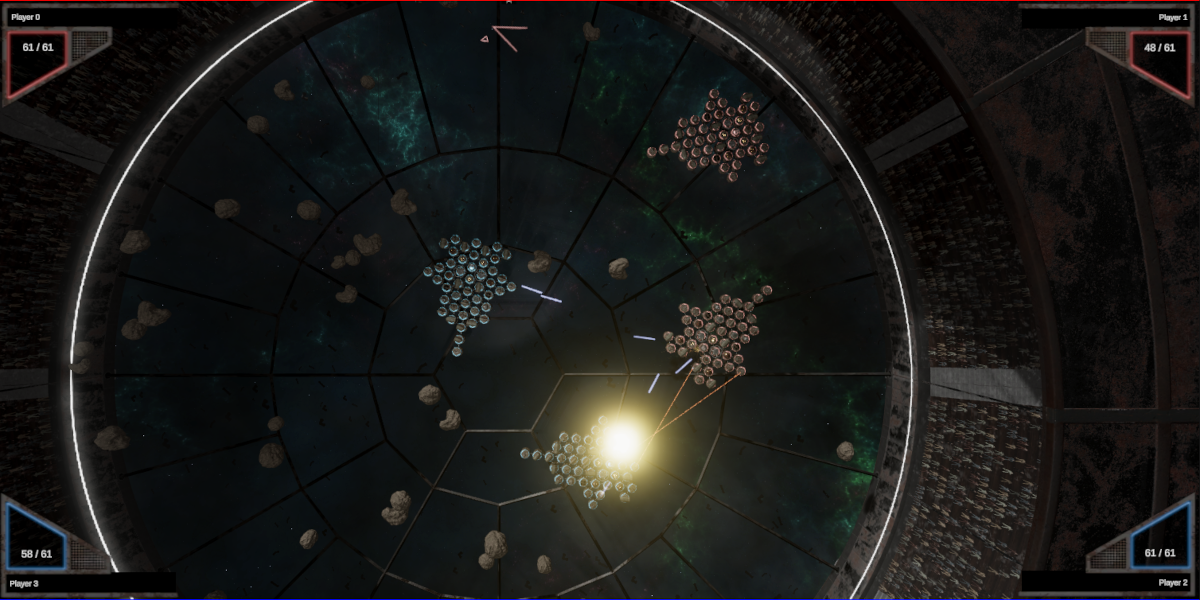
Lots of testing is required to make this work, so I have to organize multiplayer sessions at some point. I will post about those later.
One of the first posts in my dev diaries was about the difficulty of writing anything right after a release. Things haven’t changed. Last couple of weeks I’ve been mostly refactoring and making preparations as well as various small tweaks. So not much to show just yet, but here’s a few words, so you don’t think I’m getting lazy.
The most important improvements for 0.5.3 relate to moving and mishap handling. For instance, there will be new modules to ease the movement; perhaps a ramming weapon that would make collisions more rewarding so the movement could be utilized in battles. I’ve been also experimenting with a more forgiving energy mode, where overheating no longer destroys the energy sources. Instead, functions would just be unusable until energy sources have cooled down. How the cooldown period should work and how it should be visualized, is still to be decided. I will probably add difficulty settings for movement and energy handling. This would enable careless, easy matches as well as devilishly difficult ones.
But the feature I’m personally most excited, is the new team mode. It allows two teams (2-3 players per team, 4 in total) to match against each other. Humans and AI combatants can be freely assigned to both teams, so the current, limited cooperative mode will become needless. More about this in the next post, once I have time to design it more.

All right, I FINALLY got the version 0.5.2 finished and out! Releasing seems to get harder each time.
As usual, builds for Windows, OSX and Linux can be freely downloaded. Especially the OSX and Linux versions were hard to test extensively, so feedback is highly appreciated.
There has been a little pause in my development process, but I already have some kind of roadmap, so it’s time to clean up the TODO lists and kick off the 0.5.3 cycle. More about the future plans in the next post.
I’ve been experiencing some frustrating technical problems, which have slowed down the release process, testing and writing. Once I get the version 0.5.2 out (hopefully in a week or two), it’s time for a hardware upgrade.
But about the game.
One particular issue has been troubling me during the final testing: as the game has gotten more complex, the number of ways to screw things up has increased steadily. I actually gave mishaps a whole new statistics page for future expansions:

With all the hassle, it is often hard to tell if incidents are bugs or just unfortunate mishaps. This can become frustrating, and too much of the player’s concentration is now wasted on being careful. Even the best AI pilots aren’t immune to accidents. In fact, various collision fixes resulted in cases where AI opponents blew themselves up at the start. They should be more careful now.
Many of the incidents are somehow related to energy, and it looks like notifications about destroyed energy sources are not enough to clarify them. In the future, I will probably add a mode, where overheating no longer destroys the energy sources. Instead, all functions would just be disabled until energy sources have cooled down.
Another common mishap are cases where the colliding projectiles damage the ship that just launched them. These are double as harmful as normal hits, since projectiles cause damage simultaneously. Cannons can also blow up projectiles; these cases became more common after I fixed various collision bugs from the previous versions. Both projectile-projectile and cannon-projectile collisions are usually (but not always) due to aggressive spam-clicking.
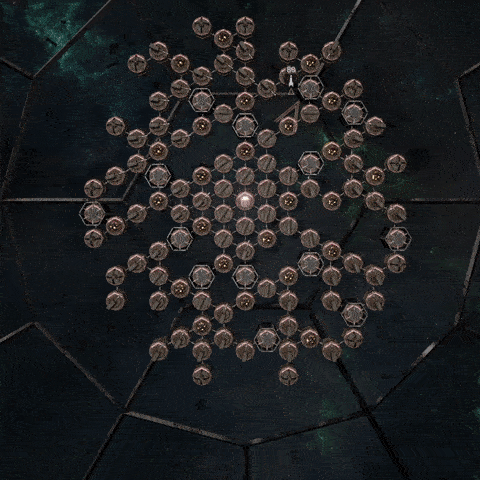
Players can also get direct hits from their own projectiles. These cases are easier to detect, but one curious corner case has risen: the best AI pilots are pretty good with pressor beams, and constantly push projectiles back towards the launchers. So when you see mishap info about a direct hit, it might be because of this. Be careful when shooting missiles from a close range.

As a summary: it is hard to explain complex events in an arcade game’s feedback loop. In typical simulations, tempo is slower, making it possible to open up the causality; in arcade games, there’s no possibility to do so without interfering with the game flow. Text notifications are quite bad, as no one reads the messages during the battle. An icon flash etc. on the crosshair would probably be better. I will try to improve this in the upcoming versions. As always, feedback is welcome.
Thanks.
About those unpredicted simulation issues I mentioned earlier…
Many unexpected things can (and will) happen in physics simulations, many of them because of the mathematical inaccuracies. So far ATP has mostly used discrete collision detection, which is performant, but sometimes unable to handle small objects with great velocities. In the animation below, for instance, a pressor beam gives the missile a double push, causing it to speed through a module.
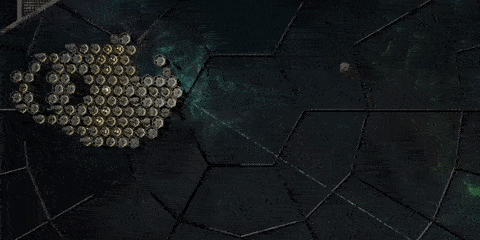
Limiting the velocity probably helps somewhat, but similar may happen also on CPU hiccups. For a more complete solution, three collision calculation modes are introduced:

Settings page is quite badly organized. I should probably re-group all the performance-related stuff, both graphical and physical. But as I have the version 0.5.2 pretty much wrapped up (and tested also on Linux), that’s a job for 0.5.3.
Unity Hub writes log files that may give some clues. See the bottom of page https://docs.unity3d.com/Manual/LogFiles.html.
That said, Hub seems rather unstable at times. I’ve had to un- and re-install it several times during the last couple of years. So that might help also (it shouldn’t affect Unity Editor installations).
Crosshairs are pretty much the most important source of information in ATP. They have changed a lot during the development, as can be seen from the history video I posted earlier. They must meet two, often conflicting requirements: be clearly visible, but not get in the way. Earlier version (seen below) didn’t quite succeed with the latter one.
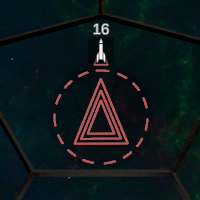
I had already reduced the crosshair opacity. To take things further, I got rid of the useless outer circle, which (I think) had some kind of purpose that I’ve since forgotten. Additionally, closed aiming triangles and rectangles were simplified, and two lines to indicate simultaneous shooting is enough instead of previously used three.
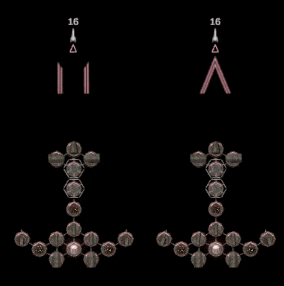
The circular energy bar opacity now increases with the energy consumption. In order to keep players aware of the usage, the circle starts blinking when the consumption exceeds 66%.
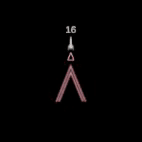
Adding the bloom effect was easy, as crosshairs are world-space UI-components. Nowadays additive GUI shaders can be made by creating a “Sprite Unlit Shader Graph” asset, and setting blending mode to “Additive”; I should probably replace my custom additive GUI-shader with this. It seems that the overlay camera’s bloom is also applied to the base camera, so game view and crosshairs must share the same post-processing effects. I may be missing something, but I didn’t find any way to change this via layers or anything.
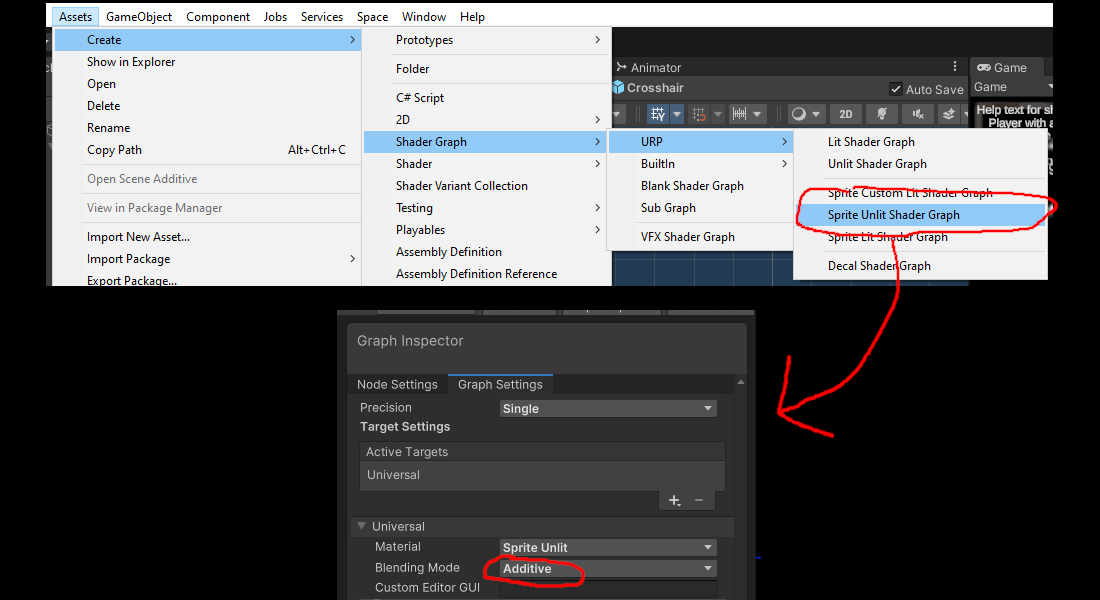
This is how the new crosshair looks in use.
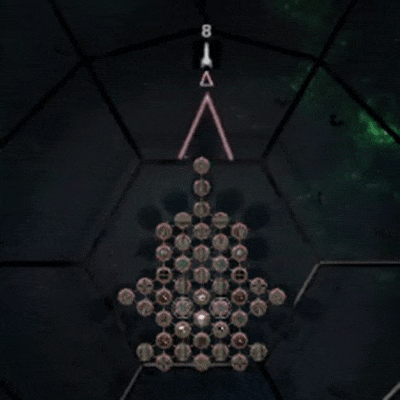
Beside this, I renamed and re-balanced some modules. As it often happens in simulations, every fixed feature seems to break two others. So (once again) it took longer than I expected.
My computer is starting to fall apart, which slows down things. Hopefully I get the version 0.5.2 out before I’m forced to get a new one. For the next release, there are plenty of small things going on that are harder to explain than fix. But fortunately something visual too.
I recently found a suitable asset to replace the previous placeholder lens flares: SRP Lens Flare, a free product in Unity’s asset store that is well worth advertising. With a little customization, I got pretty much what I was after, and now the sun and artificial lights look like they should.
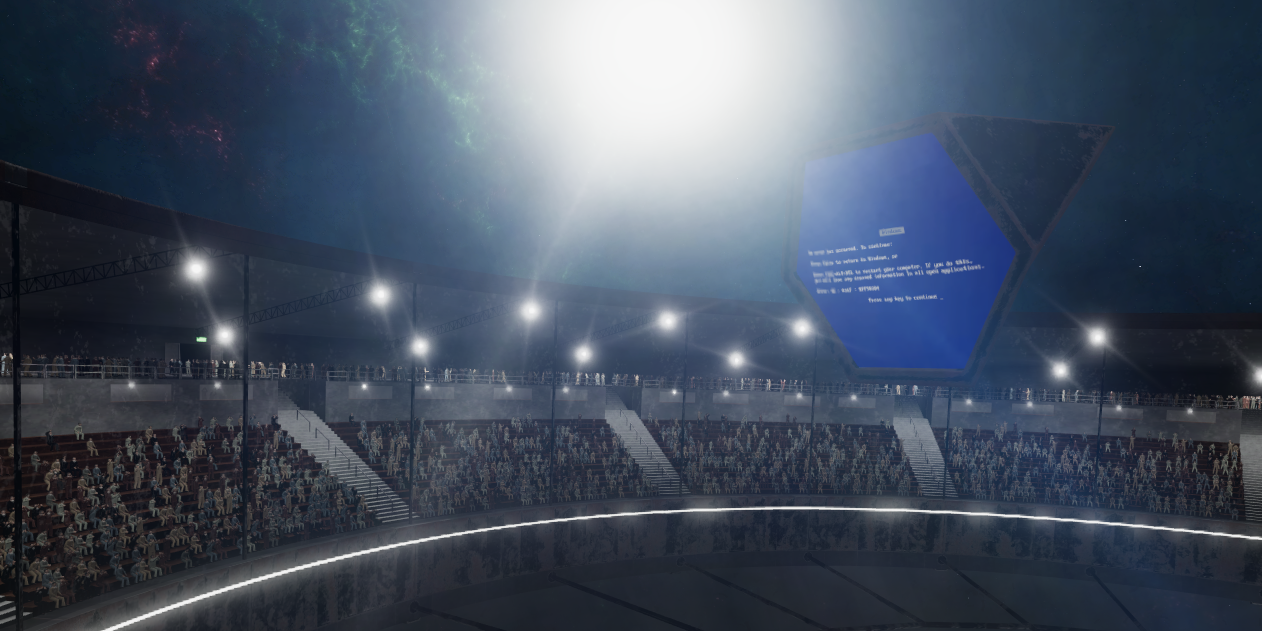
There was also a glitch with the shadows. Hardly noticeable one, but irritating when found. Arena geometry that is never visible in the top-down view was culled from the battle camera by assigning it with a special layer. This geometry included the arena's outer walls. In Unity, only visible layers seem to cast shadows, which made sunlight leak to the arena (see left image below). Fixing was easy: just a change to the geometry's layer. But of course, larger shadows darkened the arena, which had to be compensated by increasing ambient light. Hopefully this doesn’t reintroduce the brightness balancing problems I used to have. Image on the right shows what the shadows should look like.
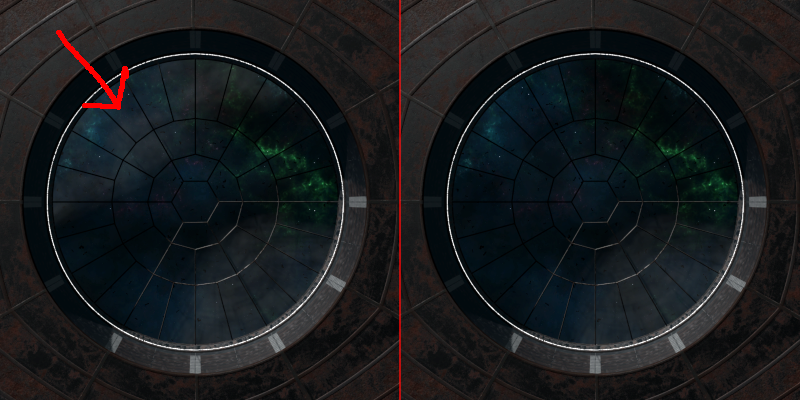
I also redesigned the crosshair and made it simpler, which I will tell more about in the future. And I created a Twitter-page! As I’ve never been much into social media, the next thing is to figure out what the heck I should do there...